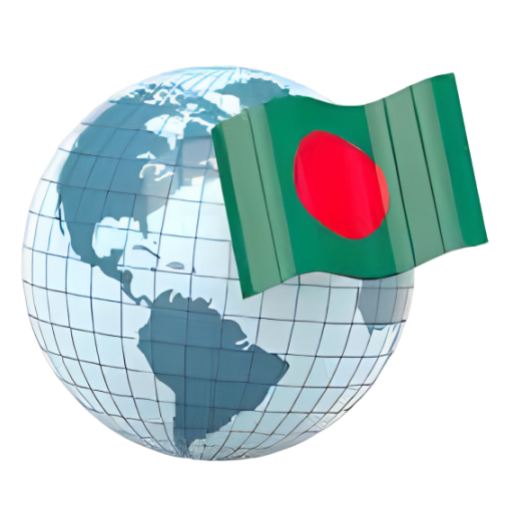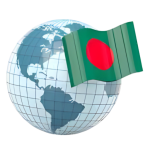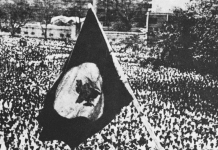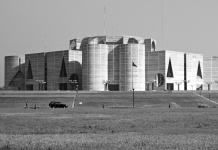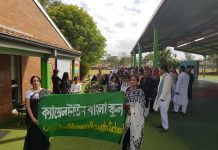The first issue of Volume 2 of Global Bangladesh covers three significant milestones of Bangladesh’s emergence as a Sovereign Nation State. All three involved martyrdoms – for linguistic and cultural rights in February (1952); for democratic and economic rights in January (1969); and for independence in March (1971).
The seed of independence, sown in February 1952, gained momentum in the January 1969 mass uprising and culminated in the declaration of independence on 26 March 1971. The events of March 1971convinced Bangabandhu to declare, “এবারের সংগ্রাম আমাদের মুক্তির সংগ্রাম, এবারের সংগ্রাম স্বাধীনতার সংগ্রাম”.
Thus, Global Bangladesh (Volume 2, Issue 1) includes articles that relate to these milestones. Three authors recollect the events of our liberation movements from participants’ perspectives. In his article, Professor Rehman Sobhan, a leading scholar, a participant in our liberation struggle, and an architect of economic policies in the early 1970s, provides a vivid account of the tumultuous events during the January-March period in 1971. He highlights the roles of hawks in the Pakistan military, General Yahya, and Bhutto in their negotiations with Bangabandhu Sheikh Mujibur Rahman and other Awami League leaders during March in 1971 and explores the reasons for failures in negotiations that led to the genocidal crackdown in Bangladesh by the Pakistan military.
Professor Anis Chowdhury recounts the tempestuous moments of March 1971 in Chattagram, which became an epicentre of our liberation struggle. He narrates how the role of declaration of independence fell on Major Ziaur Rahman and the responsibility for a follow up political statement on MA Hannan in the midst of a leadership vacuum within the Awami League and confusions among other major political parties, such as both factions of the National Awami Party. He also highlights the momentum created by the visits of Moulana Bhashani and Kazi Zafar Ahmad to the city. Anis Chowdhury recognizes the roles of literary figures and cultural activists, such as Abul Fazal and Professor Momtazuddin Ahmed, in galvanizing and directing people’s rage towards the struggle for independence, such as the heroic efforts of the people of Chattagram in blocking the unloading of weapons from MV Swat, amid uncertain and chaotic political circumstances in Chattagram. He also highlights the role of some cultural personalities of the Chittagong radio station, such as Belal Mohammad and Abul Kashem Shandeep, and a few radio technicians in securing the Kalurghat radio station from where Major Zia made the declaration of independence.
University students, especially students of Dhaka University, played a pivotal role in our liberation movement. Dr. Nazma Ahmad, in her article, provides a moving account of her journey in student and national politics in 1969. She describes in detail her activities as an activist in left-wing student organizations such as the East Pakistan Student Union and later Biplobi Chattra Union, especially in demonstrations against the prevailing repressive regime. She recounts the origin of the 11-point charter of student organizations. She vividly describes her direct involvement in violent confrontations against the police on January 20, 1969 when Asaduzzaman was shot dead by the police. The blood-soaked shirt of Asaduzzman, which Nazma Ahmad managed to hide in her vanity bag, and later displayed in demonstrations, helped catalyze student movements into a national mass movement.
Preservation and promotion of the Bangla language are major challenges for the Bangladeshi diaspora community. Three authors narrate how the Bangladeshi diaspora community tries to preserve Bangla language and culture for younger generations. Abdul Jalil in his article, describes the efforts that are being made to provide Bangla language lessons for children in major cities in Australia at community and mainstream schools. The article also mentions challenges of establishing and maintaining Bangla language programs such as availability of dedicated volunteers and teachers and support of guardians.
Mirza Golam Sabur in his article, presents a successful story about how the Bangladeshi diaspora community is preserving and promoting the Bangla language and culture in Singapore. The Bangladesh Language and Cultural Foundation (BLCF), established in 2000, has established a Bangla school and has been successful in having recognized Bangla as one of the non-Tamil Indian languages in Singapore. The article recognizes the role of the BLCF in organizing cultural activities and the role of parents, teachers, and students in promoting Bangla language and culture.
Chowdhury Salahuddin Mahmood, in his article, describes the role of the Federation of Bangladesh Associations in North America (FOBANA) in maintaining and promoting the Bangla culture. Since its inception in 1987, the FOBANA, as an umbrella organization, annually holds socio-cultural functions in major cities in the United States and Canada. The article describes various programmes of the 37th FOBANA conference held in Dallas in 1923. A notable feature of this meeting was an exhibition of books, documents, and pictures collected by Mahbubur Rahman Jalal, a freedom fighter. At this event the BUET Alumni Association paid tributes to Dr. F.R. Khan, a famous structural engineer.
Established on the principles of ‘Nationalism’, ‘Democracy’, ‘Socialism’ and ‘Secularism’, Bangladesh has passed half a century as a Sovereign Nation State. Professor Rashed Al Mahmud Titumir, a well-known political economist, in his article, narrates the progress and challenges witnessed by Bangladesh during the last five decades. The article illuminates the rising level of GDP and high economic growth in Bangladesh. However, he also highlights some challenges facing Bangladesh such as growing income inequality, high unemployment, capital flight, lack of quality in education and healthcare, degradation of the environment, and lack of inclusive political institutions. These challenges, according to Professor Titumir, pose major obstacles to achieving three core objectives of the War of Independence: human dignity, equality, and social justice.
The Bangladeshi diaspora community residing in 176 or so countries, comprises temporary workers, and permanent residents in these countries. A new category of this community includes some who have lived and worked in several countries without losing their connections with Bangladesh. The article by Desh Ferot (a pen name) provides a fascinating account of the lives he lived in several countries including Bangladesh, UK, USA, Saudi Arabia, and Australia. It appears that he has led a life of an international nomad. Yet, over time, his connections with Bangladesh have deepened rather than waned. As an engineering consultant in water and environmental sectors, he has worked in 30 districts in Bangladesh.
Desh Ferot’s article fulfils an important mission of Global Bangladesh. That is, to provide a platform to connect the Bangladeshi diaspora to Bangladesh. We sincerely hope that this will encourage the progenies of Bangladeshi diaspora to remain connected with their roots so that Bangladesh can gain from their expertise, and the knowledge of a wider world.
Bangladesh is a deltaic country where more than 20 million people live on char islands. Most of the people on char islands are routinely affected by flood, land erosion, and natural disasters. Dr. Mohammad Zaman, as a field worker, researcher, and consultant, narrates the lives of people on char islands, especially Kazipur in Sirajganj district. He highlights the history and short-comings of river management projects in Bangladesh. He calls for a holistic approach toward managing flood and land erosion beyond the engineering approach.
Because of geographical location and climate, Bangladesh has high floral and faunal biodiversity. The article by Professor Sajeda Begum identifies various migratory birds that can be observed in Bangladesh during the winter and summer seasons. The article observes that sand dunes in coastal areas are important habitats for migratory birds. Professor Sajeda Begum highlights that indiscriminate human activities, such as fishing, hunting, and expansions of agricultural activities pose serious threats to habitats of migratory birds. She calls for increased awareness concerning migratory birds and more effective conservation policies.
The influx of a million Rohingya refugees in Bangladesh presents a major international humanitarian crisis. Provision of basic necessities such as food, shelter, healthcare, and education for refugees in crowded places in Cox’s Bazar remains a major challenge. The presence of refugees has also had serious negative socio-economic consequences for local communities. Professor Rezaul Islam, in his article, calls for increased transparency in government policies toward the Rohingya crisis and increased coordination with international partners.
Vietnam, once poorer than Bangladesh and devasted by wars, has emerged as a booming economy. Professor Habiba Zaman narrates the geographical beauty and historical places of Vietnam based on her trip in 2023. She describes the food and culture in cities such as Hanoi, Da Nang, Hue, Hoi An, and Ho Chi Minh City (formerly Saigon). She also provides her impressions about the War Museum Remnants in Ho Chi Minh City which has meticulously preserved the horrific images of the Vietnam war. In this museum there is a Bangla poster with a slogan of ‘Lal Salam’ (red salute), prepared by the Communist Party (Marxist) of West Bengal, supporting the heroic struggle of the Vietnamese people.
We sincerely hope that our readers will enjoy reading this issue of Global Bangladesh. I would like to thank the editorial team and the technical support person, Mr. Mahbub Rahman for working hard to bring out this issue. Our next issue is due in June. We encourage our readers and well-wishers, especially among the younger generations, to submit their articles on various issues confronting the country and Bangladeshi diaspora community. The deadline for submission for Vol. 2, Issue 2 (June) is 31st May, 2024.
